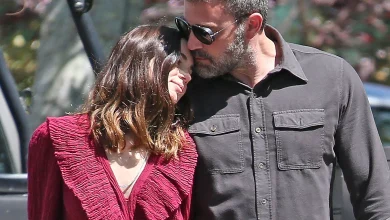The Arecibo Observatory in Puerto Rico
Exploring the Magnificent Radio Telescope Fom Goldeneye
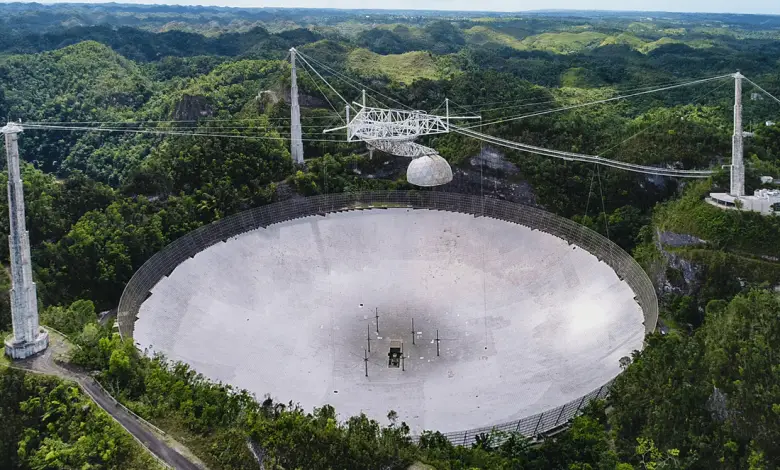
Welcome to our comprehensive guide to the Arecibo Observatory in Puerto Rico, an extraordinary scientific and cinematic landmark. In this article, we will delve into the rich history, scientific contributions, and cultural significance of the Arecibo Observatory. From its origins as a Cold War defense tool to its pivotal role in the search for extraterrestrial intelligence, this iconic radio telescope has captivated the imaginations of both scientists and movie enthusiasts alike. Join us on a journey to explore the awe-inspiring world of the Arecibo Observatory.
Key Takeaways
- The Arecibo Observatory in Puerto Rico is one of the largest radio telescopes in the world, initially designed for national defense during the Cold War. It later became instrumental in the search for extraterrestrial intelligence (SETI) and various aspects of radio astronomy.
- The observatory’s immense dish, suspended on cables above a natural sinkhole, is a marvel of engineering. It was the largest single-aperture telescope until 2016 when surpassed by the Five hundred meter Aperture Spherical Telescope (FAST) in China.
- The Arecibo Observatory gained significant pop culture recognition through its appearance in the James Bond film GoldenEye, where it played the role of Alec Trevelyan’s secret satellite control center.
- Unfortunately, the observatory faced challenges in recent years, including damage from an earthquake in 2014 and the devastating impact of Hurricane Maria in 2017. Ultimately, the main telescope collapsed in 2020 due to safety concerns and structural issues.
Arecibo Observatory: From Cold War Defense to Astronomy Marvel
The Arecibo Observatory, completed in 1963, was initially designed for national defense purposes during the Cold War era. Its primary mission was to detect Soviet satellites, missiles, and bombs, reflecting its crucial role in safeguarding the United States. However, as the Cold War waned, the focus of the observatory shifted towards scientific research, particularly in the fields of radio astronomy and the search for extraterrestrial intelligence (SETI).
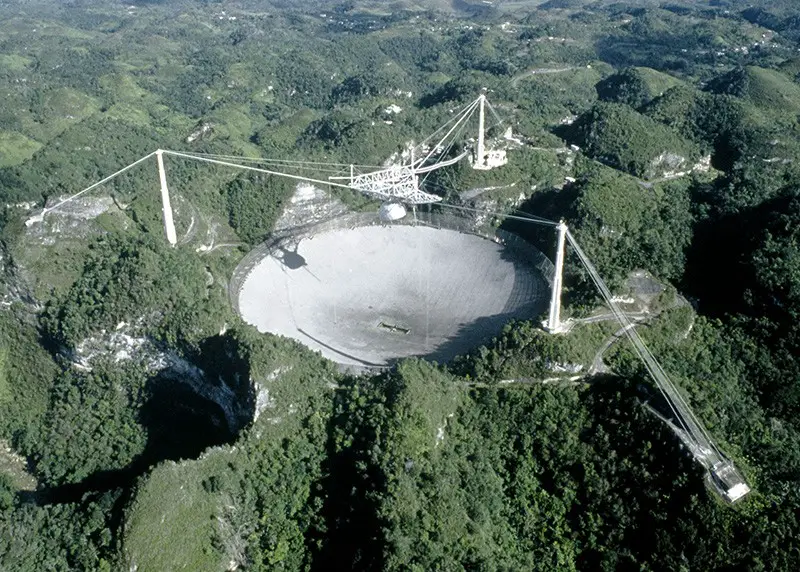
Unveiling the Immense Dish: A Marvel of Engineering
At the heart of the Arecibo Observatory lies its colossal radio telescope, a staggering 1,000-foot (305-meter) structure that was, until July 2016, the largest single-aperture telescope in the world. Suspended above the immense dish are cables that support the telescope, creating a stunning sight against the backdrop of the Puerto Rican landscape.
GoldenEye: Arecibo Observatory’s Cinematic Debut
Fans of the iconic James Bond franchise will recognize the Arecibo Observatory from the 1995 movie GoldenEye. In the film, the observatory’s large dish plays a crucial role as Alec Trevelyan’s secret satellite control center. Although the storyline places the dish in Cuba, the scenes featuring the Arecibo Observatory were primarily filmed on a studio lot in May 1995, utilizing visual effects and miniature models.
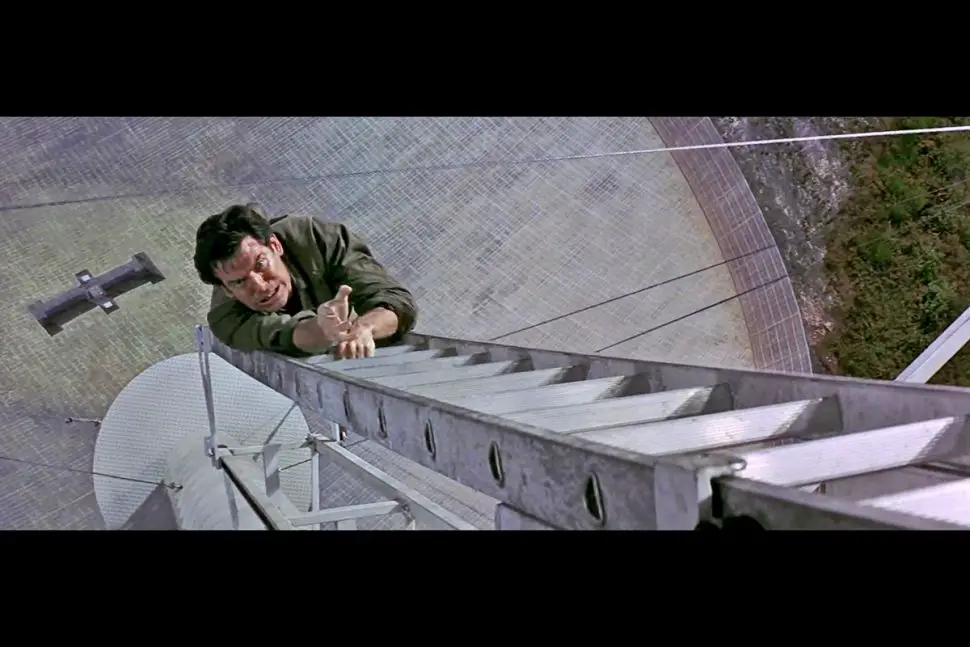
The Astonishing Scale Model: A Cinematic Masterpiece
To capture the awe-inspiring shots of the satellite dish, a massive 1:20 scale model of the Arecibo Observatory was meticulously crafted. This miniature model measured an impressive 50ft (15m), accompanied by surrounding mountains standing at 100ft (30m). The GoldenEye chapter in the TASCHEN James Bond Archives book offers an incredible glimpse into this cinematic masterpiece, allowing fans to appreciate the attention to detail and craftsmanship.
Behind the Scenes: Bond’s Adventurous Slide
One of the most thrilling moments in GoldenEye involves Pierce Brosnan’s Bond and Izabella Scorupco’s Natalya sliding down the dish. However, these scenes were filmed elsewhere, as the real Arecibo dish features a metal mesh rather than concrete. A behind-the-scenes photo capturing this exciting sequence can be found on Alamy, providing a captivating glimpse into the movie-making process.
The Arecibo Observatory’s Filming Legacy
Beyond its appearance in GoldenEye, the Arecibo Observatory has left its mark on various other mediums. In the world of video games, it served as a level in the highly popular 1997 Nintendo 64 game GoldenEye 007 and was featured in the game Just Cause 2. Furthermore, the observatory made notable appearances in the film Contact (1997) and The X-Files episode “Little Green Men” (Season 2, Episode 1), further cementing its cultural significance.
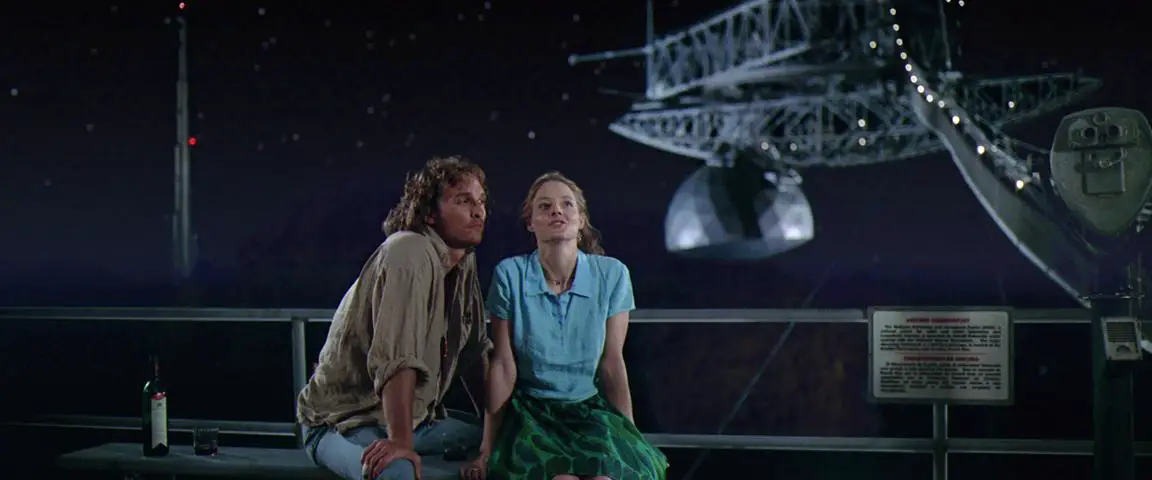
A Popular Tourist Attraction: Discover the Arecibo Observatory
The Arecibo Observatory attracts approximately 100,000 visitors each year, providing them with a magnificent view of the enormous dish. Its unique blend of scientific importance, cinematic allure, and breathtaking engineering make it a must-visit destination for science enthusiasts, movie buffs, and curious travelers alike.
Challenges and Collapse: Earthquake and Cable Breaks
The Arecibo Observatory faced significant challenges in recent years. In January 2014, a destructive earthquake caused severe damage to the facility. Then, in September 2017, Hurricane Maria dealt another blow to the observatory, exacerbating the existing issues. Reports indicate that the large hanging antenna, famously depicted in GoldenEye, broke in half and fell onto the dish during these events. The subsequent cable breaks ultimately led to the National Science Foundation’s decision to decommission the telescope, citing safety concerns. Unfortunately, on December 1, 2020, before controlled demolition could be conducted, the main telescope collapsed.
FAQ:
1. How did the Arecibo Observatory contribute to national defense during the Cold War?
During the Cold War, the Arecibo Observatory played a crucial role in national defense. It was initially designed to support efforts to detect Soviet satellites, missiles, and bombs. The observatory’s powerful radio telescope provided the United States with valuable intelligence, helping to monitor and understand potential threats from the Soviet Union. By tracking and analyzing signals in space, the observatory aided in enhancing national security and maintaining strategic superiority during that tense period.
2. What is the significance of the Arecibo Observatory’s immense dish?
The Arecibo Observatory boasts an enormous dish measuring 1,000 feet (305 meters) in diameter, making it one of the largest single-aperture telescopes ever built. This size was essential for capturing and collecting radio waves from distant celestial objects. The immense dish allowed researchers to study a wide range of phenomena, including pulsars, galaxies, and even signals that could indicate the presence of extraterrestrial intelligence. Its large size provided a high sensitivity and resolution, enabling groundbreaking discoveries and advancements in the field of radio astronomy.
3. How was the Arecibo Observatory involved in the search for extraterrestrial intelligence (SETI)?
The Arecibo Observatory became instrumental in the search for extraterrestrial intelligence. Its powerful radio telescope allowed scientists to scan the cosmos for potential signals emitted by intelligent civilizations beyond Earth. Through the SETI program, researchers analyzed vast amounts of data collected by the observatory to identify any patterns or anomalies that could signify communication from extraterrestrial sources. Although no definitive evidence of extraterrestrial intelligence has been discovered, the Arecibo Observatory’s contributions to SETI have expanded our understanding of the universe and sparked ongoing efforts in the search for life beyond our planet.
4. Can visitors access the Arecibo Observatory?
Yes, the Arecibo Observatory is open to visitors, attracting approximately 100,000 visitors each year. Tourists have the opportunity to witness the awe-inspiring sight of the massive dish and learn about the observatory’s history, scientific research, and its impact on various fields of study. Visitors can enjoy guided tours, informative exhibitions, and stunning views of the telescope. The observatory provides an engaging and educational experience for those interested in astronomy, technology, and the wonders of the universe.
5. What role did the Arecibo Observatory play in the James Bond movie GoldenEye?
The Arecibo Observatory played a prominent role in the 1995 James Bond film GoldenEye. In the movie, the observatory’s large dish was depicted as Alec Trevelyan’s satellite control center hidden in an artificial lake in Cuba. While some scenes were filmed on location, many were shot using visual effects and miniature models on a studio lot. The cinematic portrayal of the Arecibo Observatory in GoldenEye brought international attention to the observatory, further enhancing its reputation as an iconic scientific and cultural landmark.
6. How was the collapse of the Arecibo Observatory’s main telescope prevented?
Unfortunately, the collapse of the Arecibo Observatory’s main telescope became inevitable due to safety concerns following cable breaks and significant damage. The National Science Foundation had initially planned a controlled demolition. However, before the demolition could be executed, the telescope collapsed on December 1, 2020. Efforts to prevent the collapse and preserve the observatory’s infrastructure were explored, but ultimately, the structural integrity of the telescope could not be sustained, leading to its unfortunate demise.
7. What other movies and video games featured the Arecibo Observatory?
Apart from its appearance in GoldenEye, the Arecibo Observatory has made notable appearances in other movies and video games. It can be seen in the 1997 film Contact, starring Jodie Foster, which explores the theme of extraterrestrial communication. Additionally, the observatory served as a level in the popular 1997 Nintendo 64 video game GoldenEye 007, immersing players in a thrilling virtual world inspired by the movie. The Arecibo Observatory’s on-screen presence has further solidified its cultural significance and global recognition.
8. Has the Arecibo Observatory contributed to significant scientific discoveries?
Absolutely! Over its decades-long operation, the Arecibo Observatory has contributed to numerous significant scientific discoveries. It played a pivotal role in advancing our understanding of pulsars, revealing new insights into these rapidly rotating neutron stars. The observatory also facilitated studies of the ionosphere, providing valuable data on Earth’s upper atmosphere. Additionally, Arecibo’s observations of near-Earth asteroids have contributed to identifying potential threats and enhancing our preparedness for potential impact events. The observatory’s rich scientific legacy continues to impact various fields of research.
9. What were the main challenges the Arecibo Observatory faced?
The Arecibo Observatory faced significant challenges in recent years. In January 2014, it suffered severe damage from an earthquake, impairing its functionality and requiring extensive repairs. Furthermore, Hurricane Maria in September 2017 inflicted additional harm, exacerbating the existing structural issues. These challenges significantly impacted the observatory’s operations and raised concerns about safety and sustainability. Ultimately, the accumulation of damage, including cable breaks, led to the difficult decision to decommission the telescope.
10. What is the current status of the Arecibo Observatory?
As of the knowledge cutoff date in September 2021, the Arecibo Observatory’s main telescope has collapsed, bringing an end to its remarkable legacy. The National Science Foundation continues to assess the damage and explore potential future plans for the facility. While the collapse of the main telescope marked a significant loss, the Arecibo Observatory’s impact on science, popular culture, and the human fascination with the universe will endure for years to come.
Conclusion
The Arecibo Observatory has left an indelible mark in both the scientific and entertainment worlds. Its enormous dish, groundbreaking research, and appearances in popular culture have elevated its status to that of an iconic symbol of human curiosity and exploration. Despite the challenges it faced, the Arecibo Observatory will forever be remembered for its contributions to national defense, radio astronomy, and the search for extraterrestrial life. As we bid farewell to the fallen telescope, we carry forward the spirit of discovery it embodied, inspiring future generations to push the boundaries of knowledge and reach for the stars.








